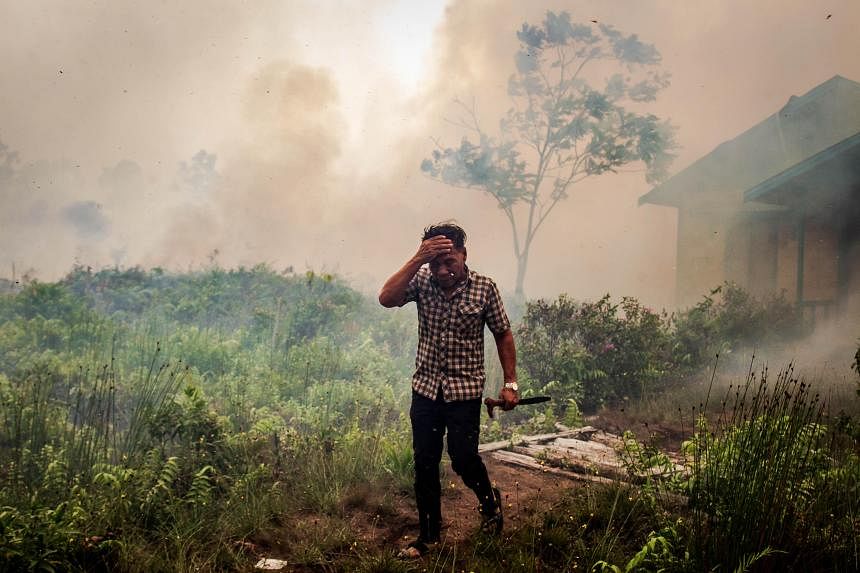JAKARTA - In the sky above Sumatra, cloud-seeding aircraft have been trying to induce rain, even in these wetter months, to fill up dams and prevent flammable peatlands from drying out.
Cloud seeding in anticipation of the El Nino weather phenomenon expected later in 2023 is crucial to prevent devastating forest fires, say the authorities. If they wait too long to start the process, there will be few rain clouds in the dry month of August to seed.
Indonesia says it is readier this year than it has been in the past for the brutal onslaught of El Nino, which develops when sea surface temperatures in the eastern part of the Pacific Ocean rise, bringing warmer and drier conditions to South-east Asia.
Personnel and equipment have been significantly bolstered, and a command system has been strengthened since 2020 to speed up the response to spreading fires, Indonesia’s Disaster Management Agency (BNPB) told The Straits Times.
South Sumatra, where thick haze from plantation fires in 2015 blanketed the region including Singapore, is likely to be the most affected by El Nino, forecasts by Indonesia’s meteorology, geophysics and climatology agency (BMKG) show.
“We have more equipment and personnel than we did in all the previous years. We are also doing early preparation. We expect the 2015 scenario will not recur,” BNPB’s head, Lieutenant-General Suharyanto, who like many Indonesians goes by one name, told The Straits Times. “Hot spots, fires have actually started to emerge through June, and we have doused all of them.”
Dr Abdul Muhari, head of disaster data, information and communications at BNPB, said Indonesia has allocated 38 water-bombing helicopters for the six fire-prone provinces, including South Sumatra, Riau and Central Kalimantan. He did not give figures for previous years.
“Our coordination and command system to fight fires today allow quick action, thanks to the 2020 presidential regulation that makes this possible,” Dr Abdul added. Presidential Instruction No. 3 on Forest and Plantation Fires Mitigation enables a quicker chain of command down to the lowest levels of governments across Indonesia.
Indonesia suffered several haze episodes between 1997 and 2015 as farmers and companies used slash-and-burn techniques to clear land. The fires in 1997 and 2015, both El Nino years, were especially intense, with the rampant burning worsened by severe drought.
In the following years, as Indonesia’s neighbours protested against the transboundary haze, law enforcement was stepped up, and even included an order to shoot the fire starter on sight. This, along with better firefighting equipment mandated for plantation companies, resulted in a significant decline in the scale of fires.
In response to criticism from some quarters that the rain could trigger flooding with parts of Indonesia still experiencing rainfall, BMKG’s climate variability analysis coordinator, Dr Supari, said cloud seeding cannot be delayed.
The aim of seeding, he added, is to bring about rainfall over dams, peatlands and rice paddy fields, and not over cities.
BMKG forecasts that this year’s El Nino may not be overly severe for Indonesia, as the conditions began to develop somewhat late in the year.
El Ninos that start in the second half of the year, such as those in 2019, 2009, 2006 and 2004, have tended to become weak or moderate forms.
In 2023, it started in June, close to the second half, Dr Supari said.
In 2015, El Nino had developed by early in the first quarter.
Still, rainfall for August to October is forecast to be below normal in 2023, especially in Sumatra and other regions such as Kalimantan, parts of Sulawesi and Java, said BMKG head Dwikorita Karnawati at a recent media briefing.
She noted that some regions would have very low rainfall of less than 20mm a month.
Forestry and oil palm companies have been warned to anticipate drier weather.
Asia Pulp and Paper’s (APP) fire management manager Sujika W. Lusaka said the company has 15 helicopters that can be deployed at a moment’s notice. It has 40,000km of canals and 405 monitoring posts across its plantations in Sumatra. Canals help prevent the spread of fire, maintain moisture in peatlands and are a source of water for firefighting.
APP head of strategic engagement and advocacy Letchumi Achanah said the 2015 fires, which devastated thousands of hectares of its pulp trees, prompted the company to develop an integrated fire management programme and build the required infrastructure.
APP and its affiliates have allocated 500 billion rupiah (S$44.6 million) to deal with this year’s expected El Nino, with the procurement of additional helicopters being the largest cost.
Mr Sujika told ST: “We are also ready to reactivate our health posts in our concessions as well as in nearby villages to serve the children and the elderly if they are ever in any way affected by El Nino.”
Oil palm grower Astra Agro Lestari is ready to distribute masks, and provide emergency treatment and support to the surrounding communities in Sumatra and Kalimantan if they are impacted by El Nino.
“We hope the upcoming El Nino will not last too long so the impact will be less than that in 2015,” said Mr Cahyo Wibowo, Astra Agro’s research and development vice-president.
He said the company hoped to avoid a scenario so severe that villagers would have to be evacuated.
BMKG’s Dr Dwikorita said preventive efforts this year are especially important after the rare occurrence of three straight years of wet weather caused by La Nina, the flip side of El Nino.
Wet conditions from 2020 to 2022 encouraged recalcitrant farmers and companies to again use slash-and-burn methods to clear land. But such practices will not be tolerated this year, she said.
Adding to the risk is the strong growth of oil palm and pulpwood plantations during the past three years as a result of the above-average rainfall. There is now more vegetation that can catch fire, making it harder to extinguish.
Another concern is food security.
President Joko Widodo made the politically sensitive decision to import 2 million tonnes of rice from countries such as Vietnam and Thailand for 2023, anticipating a decline in domestic production.
The move was opposed by opposition politicians and farmers, who fear a slump in the price of rice.
Indonesia, the world’s fourth-most populous country, had largely been rice self-sufficient, with an annual output of 31 million tonnes in the past four years, but the government needs to further improve irrigation systems, and build more dams to deal with drier conditions.
In a recent discussion, Ms Febby Novita, the commercial director of Bulog, the state food agency tasked with maintaining a national grain stockpile, said the agency’s worry instead was the tight global supply of rice.
Speaking at an El Nino mitigation forum on June 20, she said: “Our rice stockpile is in a worrying state… We are facing difficulty procuring rice. A few producing countries backed down on their commitment. Some of the rice from South-east Asia was shipped to Europe.”


